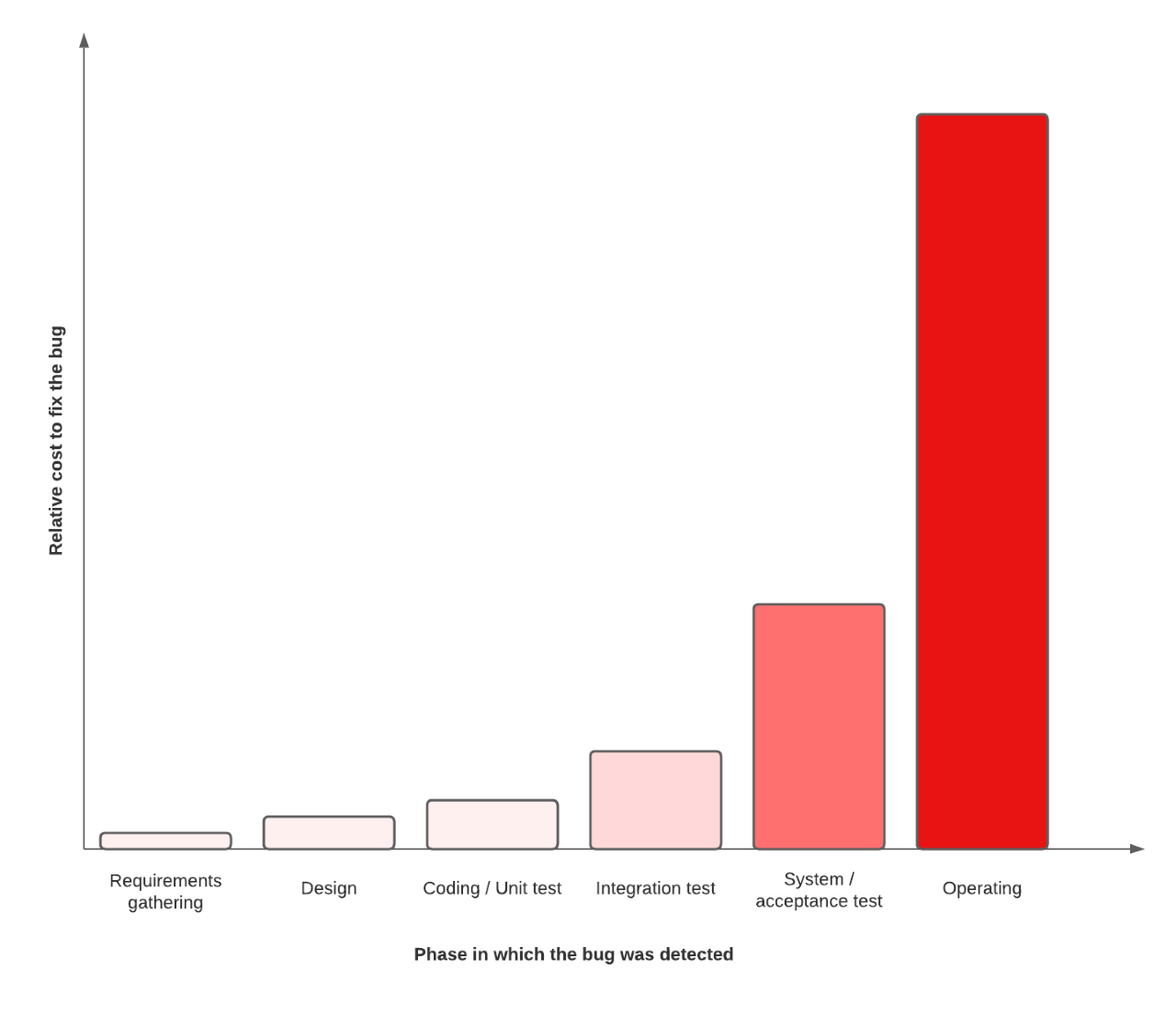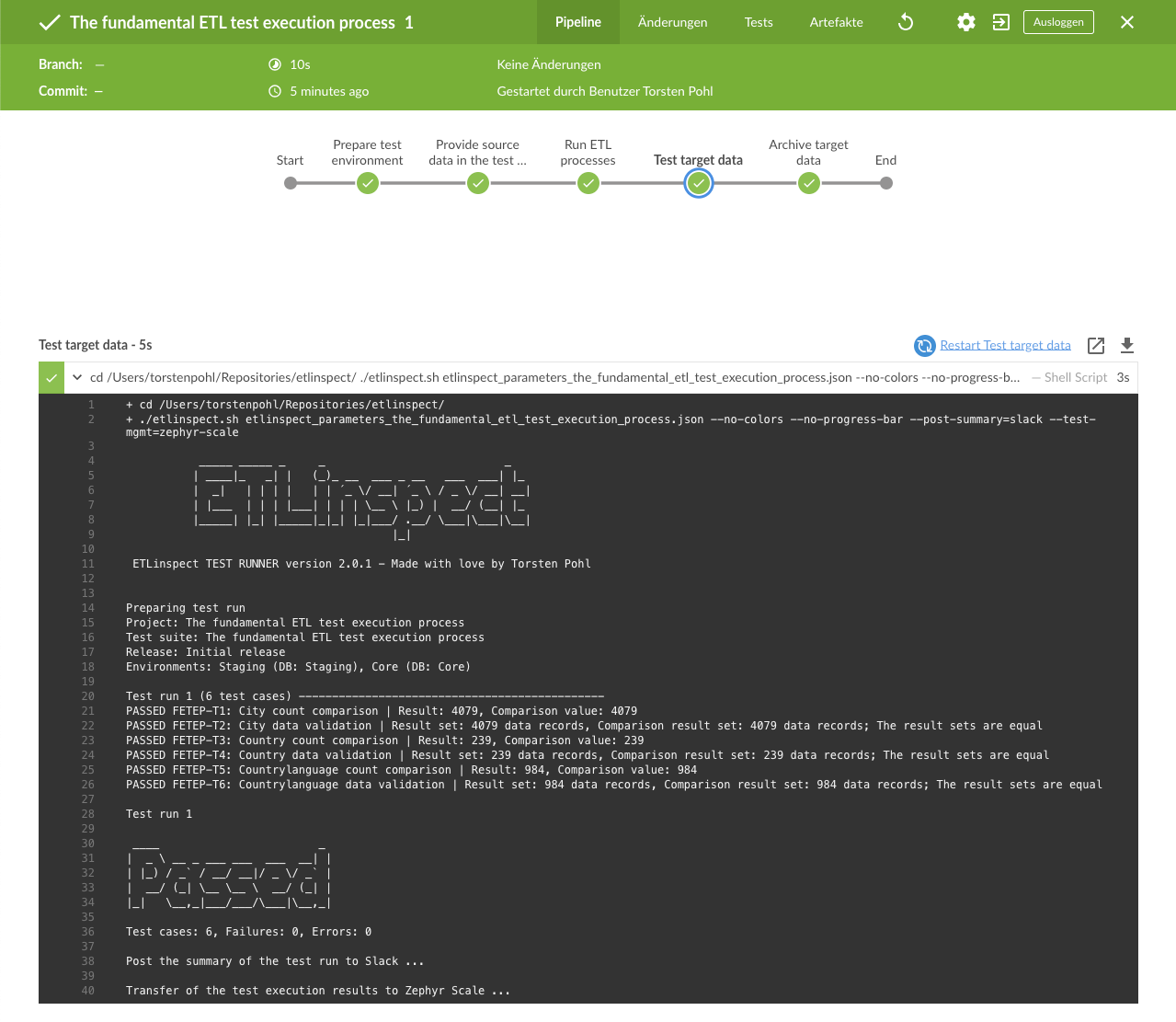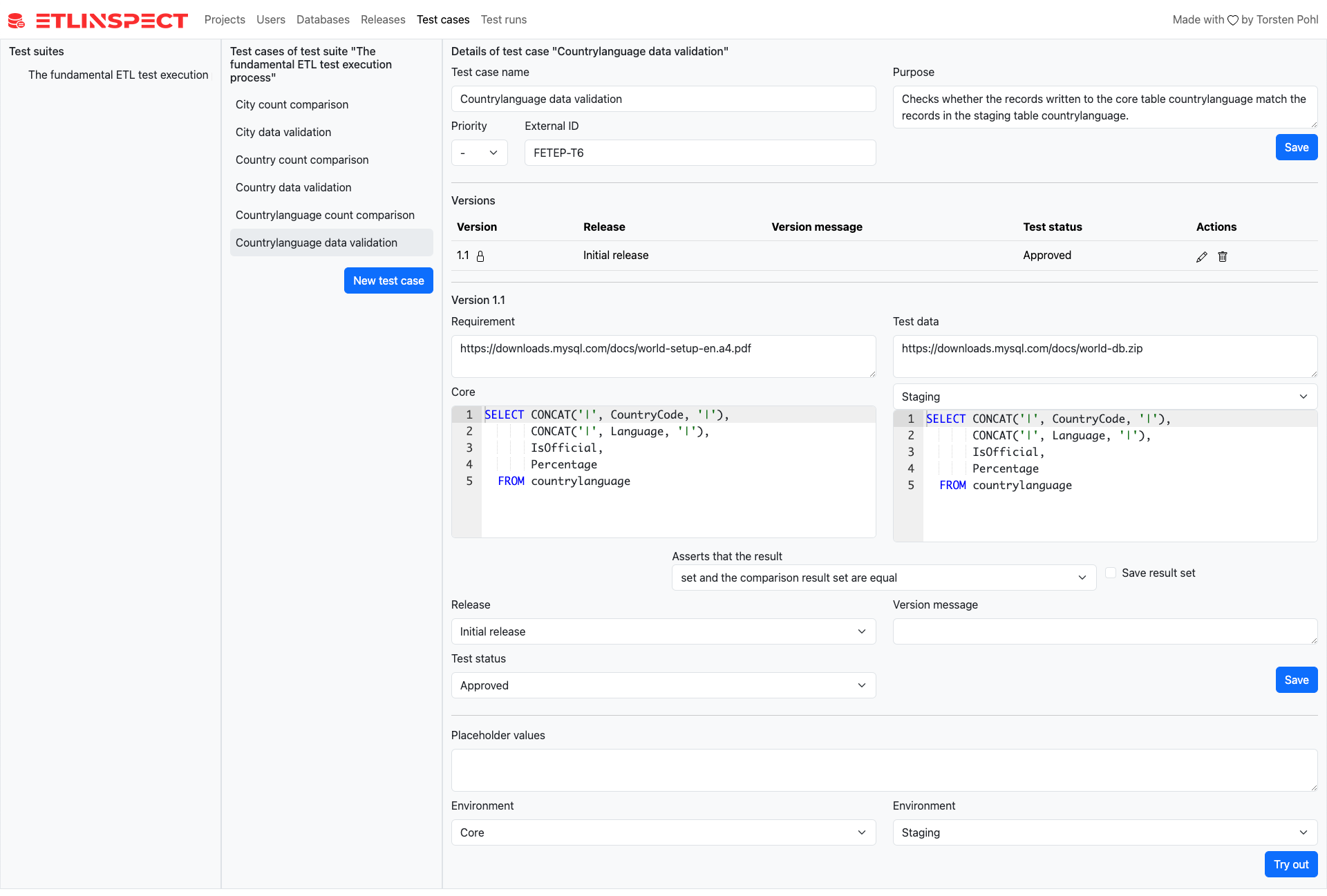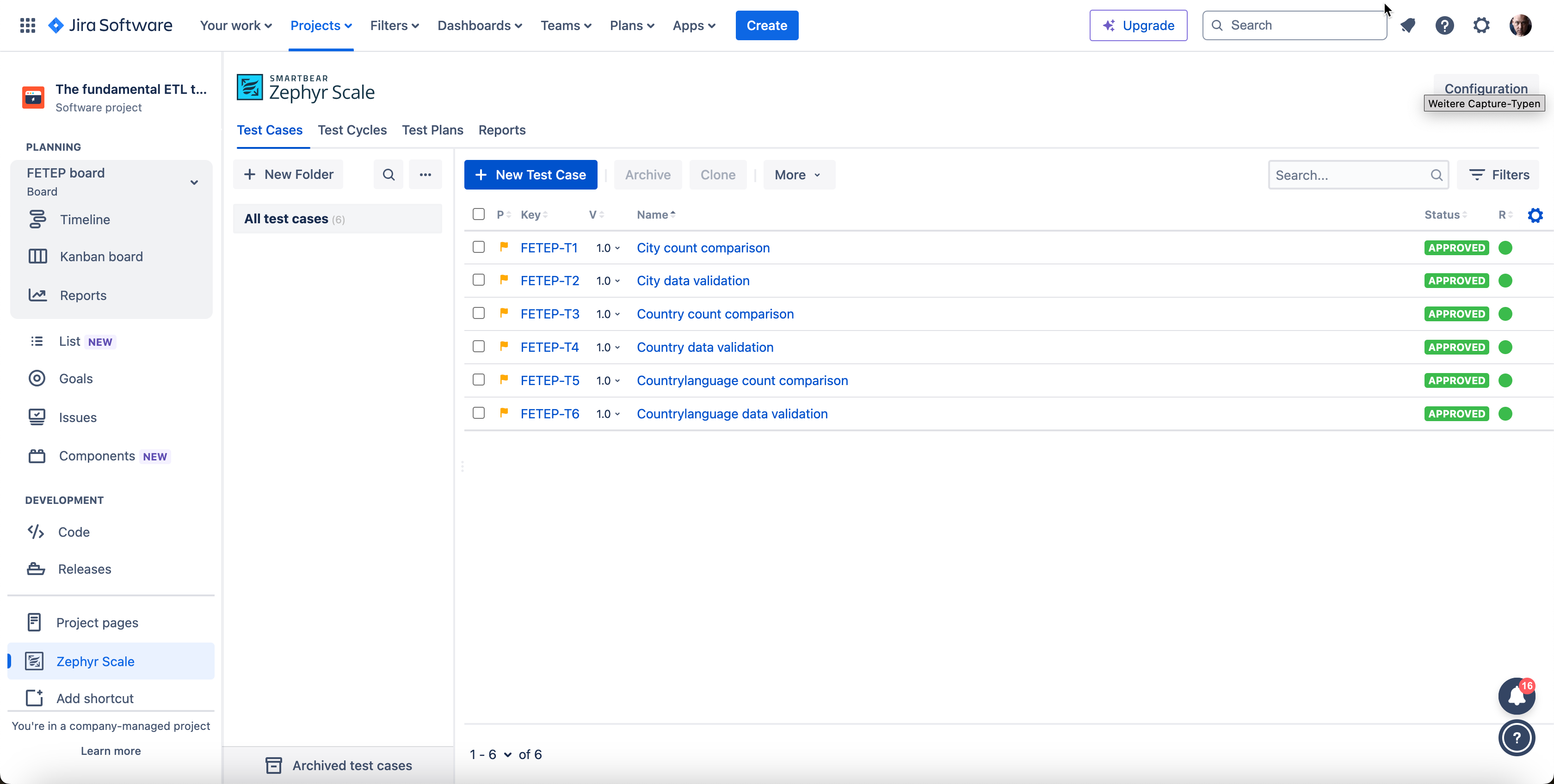ETL testing
A comprehensive overview of ETL testing! Here you will find basics, types, methods and examples for running and automating ETL tests.
Welcome to my website, which provides a comprehensive overview of ETL testing! Here, you will learn about the basics, various types, proven methods for conducting ETL tests, and the benefits of automated testing. My target audience includes developers and testers who transfer data from a source to a target environment. To successfully perform ETL tests, you should know the areas of databases, data modeling, and SQL. However, a basic understanding of programming languages is also helpful, as ETL tests are often automated.
Contents
- What is ETL testing?
- Why is ETL testing important?
- A few definitions of terms
- Testing costs vs. failure costs
- How does the ETL testing process work briefly?
- Categories of tests
- Sequential vs. iterative software development models
- What are the minimum requirements for ETL Testing?
- The fundamental ETL test execution process
- Standards and norms in ETL testing
What is ETL testing?
ETL testing is integral to business intelligence (BI) and data warehouse systems. ETL stands for Extract, Transform, and Load, referring to the three steps performed during data integration. These steps include extracting data from various sources, transforming it into a standard format, and loading it into the target system. ETL testing ensures that all data is processed completely and correctly and the target system delivers the right results. This includes tests for data quality, data integrity, and performance.
To perform successful ETL testing, it requires knowledge of data sources and the ETL process and a comprehensive testing strategy that covers all aspects. SQL queries and automated testing tools are often used to quickly and effectively identify errors.
Why is ETL testing important?
A faulty ETL process can severely damage a company, leading to inaccurate or missing data. Incorrect aggregation and misleading reports can influence critical business decisions, cause financial losses, and have legal consequences. But the most significant risk is the loss of trust from customers and partners who base their decisions on these erroneous data.
A faulty ETL process can also lead to time loss and incomplete or delayed reports and analyses. That's why ETL testing is integral to BI and data warehouse systems. A careful testing strategy and monitoring of the ETL process lead to higher data quality and better business decisions, resulting in a successful company.
A few definitions of terms
Error: Have you ever wondered what happens when a system or product doesn't work as it should? That's an error! This can happen due to unclear requirements, incorrect implementation, or unforeseen problems.
Fault state vs. Fault effect: In a fault state, a system or product is affected by an error that impairs its functionality. But what happens exactly? The fault effect describes the consequences of an error on the system or product and its environment. The impact can vary depending on the location and type of error. Some errors can cause only minor restrictions, while others are so severe that the system or product becomes unusable.
Error masking: Sometimes, an error hides behind other errors or disturbances that obscure the real problem. This can lead us to draw false conclusions and be misled. This phenomenon is called error masking and is a real challenge for anyone trying to solve problems.
Testing: Testing is like detective work; you want to detect and eliminate errors to ensure a system or product works perfectly. The testing process uses various tools and techniques to help identify possible causes of errors. Ultimately, it's about maximizing quality and minimizing potential negative impacts.
These terms are intertwined and influence each other. A single error can lead to a chain reaction, which can have unforeseeable consequences. Identifying and correcting errors can be challenging if they are masked by something else. Testing is crucial to finding and eliminating errors and ensuring that everything works as intended.
Testing costs vs. failure costs
Testing costs and failure costs are two essential terms in quality assurance. While testing costs include the costs of conducting tests and test infrastructure, failure costs refer to the potentially expensive consequences of errors that were not detected and fixed. These can range from production downtime to reputation-damaging image losses. It is, therefore, advisable to invest in quality assurance measures to avoid potential failure costs and save costs in the long run.
Start quality assurance measures early in development to avoid errors that may spread to other parts of the system and become more expensive. Detecting and fixing errors early is the most effective way to keep costs low and improve the final product. Remember that fixing errors later in the process is generally more costly.

The „Rule of Ten“ in software bug-fixing asserts that the cost of fixing a bug escalates approximately ten times with each progressive stage in the software lifecycle, from requirements gathering, design, coding, testing to deployment and maintenance. Therefore, a bug rectified at minimal cost during the requirement or design phase could potentially cost hundreds or thousands of times more to fix in the maintenance or post-deployment stages.
How does the ETL testing process work briefly?
In the ETL testing process, test cases are derived from the requirements of the ETL process. Then, a test plan is created that determines which tests are needed for which strategy. Next, the necessary data is provided in a particular test environment, and the ETL processes are executed. After that, the target data is tested, and errors are analyzed if necessary. This process can be repeated, especially for bug fixes or regression testing. As this is an elaborate process and ETL tests typically work with a large amount of data, it is crucial to automate as much as possible.
Categories of tests
The test levels of the test pyramid
The test pyramid is a valuable model for illustrating the different levels of software testing. At the bottom, unit tests check whether the components of the code function properly. In the middle, integration tests ensure that all components work together smoothly. At the top are the necessary system tests that test the entire system's functionality, performance, security, and reliability. Most tests should occur at the base of the pyramid, as unit tests can be performed quickly and efficiently and cover a wide range of error sources.

Functional vs. non-functional
Functional tests focus on verifying the functionality of systems and applications. It checks whether the various functions and components meet their requirements – correctly and completely. Non-functional tests, on the other hand, relate to performance, scalability, security, user-friendliness, and compatibility. Here, it is tested how the system reacts in different situations, how fast it works, and how easy it is to use. The security of confidential data is also tested here.
The sense and nonsense of test categorization
Testing is a complex task as many aspects need to be considered. One way to structure and make the process more efficient is to categorize tests. These categories help prioritize and ensure that all necessary tests are performed.
However, there is no clear boundary between categories, and assigning tests clearly can be challenging. It is, therefore, essential to remain flexible and choose an individual testing strategy that ensures all relevant tests are performed. Nevertheless, categories can serve as a rough orientation to ensure that the tested system or application meets the requirements, no matter what they are.
Sequential vs. iterative software development models
The world of software development offers various models for handling projects in structured ways. One of these models is the sequential, also known as the waterfall model. In this model, fixed phases are completed one after the other before moving on to the next. It is a good choice for projects with precise and stable requirements. However, iterative models, such as Scrum, divide the development process into recurring cycles and can thus respond more flexibly to changes or still-unknown circumstances. This is an approach for projects where requirements may change or are not yet fully known.
Sequential or iterative? Both have their advantages and disadvantages. However, regardless of the chosen model, test cases should be created so that they can be used for all phases of development and can also be used for regression testing because test cases are not just a small part of the development process but an integral part that should be created from the beginning and updated continuously.
What are the minimum requirements for ETL Testing?
Effective ETL testing ensures that data is correctly extracted, transformed, and loaded. But what is the minimum level of testing that should be performed?
Fundamentally, the following aspects should be verified:
- Verification of data volume: Does the amount of data transferred during an ETL load run match expectations? Filters, data additions and updates, as well as historization, should be tested.
- Validation of data content: Do the transformed and loaded data match the expected results in terms of content? In particular, mapping rules should be checked.
- Functional Tests: Depending on the technical implementation, additional functional checks are
required, including:
- Correct updating and historization of data
- Restartability of ETL jobs after a failure
Additionally, in many systems, referential integrity in the database is disabled for performance reasons. In such cases, ensuring referential integrity through ETL testing is essential.
Ultimately, ETL tests are as individual as the respective requirements – careful planning and adaptation to the specific conditions of a project are therefore indispensable.
The fundamental ETL test execution process
- Prepare test environment
- Provide source data in the test environment
- Run ETL processes
- Test target data
- Archive target data
In particular, to execute historicization tests, performing all or parts of the steps in several iterations with different data sets may be necessary.
A continuous integration tool (e.g. Jenkins) is suitable for executing and
reporting the steps:

The SQL testing tool of my choice is ETLinspect:

Interface for instant messaging – here Slack:

Interface for test management tools – here Zephyr Scale in Jira:

Based on this test execution platform, the challenge for ETL testers is to design the test data and test cases in such a way that they check all the necessary functional and non-functional aspects. How to master this challenge is the subject of the following chapters.
Standards and norms in ETL testing
As an ETL tester, it's essential to understand the standards and norms that guide the software testing field. This knowledge helps to ensure test accuracy, reproducibility, and overall effectiveness. Here are some of the key standards and norms that you should know.
- IEEE 829-2008 Standard for Software and System Test Documentation: Developed by the Institute of Electrical and Electronics Engineers (IEEE), the IEEE 829 standard outlines the format of software test documentation. Use this standard to structure your ETL testing reports, ensuring clarity and uniformity across testing cycles.
- ISO/IEC/IEEE 29119 Software Testing: The International Organization for Standardization (ISO) published the ISO 29119 standard. This set of international standards for software testing includes test processes, test documentation, test case design techniques, and test management. By following these standards, you can ensure your ETL testing processes are robust and internationally recognized.
- IEEE 730-2014 Standard for Software Quality Assurance Processes: This standard outlines creating a software quality assurance plan. In ETL testing, such a plan guarantees that the final product meets the intended quality standards.
- ISTQB: The International Software Testing Qualifications Board (ISTQB) doesn't set specific standards but offers a widely recognized certification program. Their syllabus and materials can provide valuable guidelines for understanding software testing, including ETL testing.
- Agile and DevOps Principles: Though not formal standards or norms, Agile and DevOps principles have become industry norms in managing software testing. Agile's iterative development process encourages continuous integration and testing, making it crucial for ETL testers. DevOps, on the other hand, emphasizes the collaboration between development and operations teams, reinforcing the role of continuous testing throughout the software development lifecycle. Find more on Agile principles at www.agilealliance.org. Find information on DevOps at aws.amazon.com.
Remember, standards and norms should guide your ETL testing process. They exist to ensure quality and consistency in testing practices. However, you may need to adapt these standards to the specific needs of your project or organization.
